| |
ID Tags 'Erkennungsmarken' of the Schutztruppe and
Polizeitruppe
by Klaus Ahlf
Background
The first Erkennungsmarken were
introduced in rectangle form in the 1860s to the Prussian
Army but the familiar oval type date from 1878 and would
change several times after 1915 to become basis of all
German ID tags until today. Naturally the Schutztruppe in
each colony also issued Erkennungsmarken to both their
native and European soldiers but this area of research is
very neglected. The Schutztruppe models varied sometimes
considerably from the standard model used in Europe.
Deutsch-Südwestafrika
There were two different types of
Erkennungsmarken issued to the Schutztruppe
of South West Africa. A rectangular type with rounded
corners that was unique to South West Africa and the
standard
50x35mm
oval ‘Modell
1878’ as used by the army and navy in Europe. They had two
holes punched for a neck cord and were stamped with either
the wearers unit or more generic ‘SCHUTZTR SWA’ followed by
the soldier's service number 'Stammrollennummer' with the ‘R’ prefix (possibly for
'Reich[struppe]'). The latter is more
typical for the rectangular type. According to the Swakopmund Museum, they were
introduced “quite early” in various forms, zinc for enlisted
and NCOs and nickel silver alloy (Neusilber) for officers.
Cords varied and were either black/white/red, colours of the
wearers home regiment or neutral colour.
| |

Rectangular Schutztruppe Erkennungsmarke
Stamped ‘SCHUTZTR SWA’ followed by 'R' and
the service number
Photo from 'Marken und Token der ehemaligen deutschen
Kolonien' by Nils Leipner

Rectangular Schutztruppe Erkennungsmarke
Stamped ‘SCHUTZTR SWA’ followed by
'R' and the service number.
This is the only known example with the
black/white/red cord surviving.
Photo
www.militaria-online.de
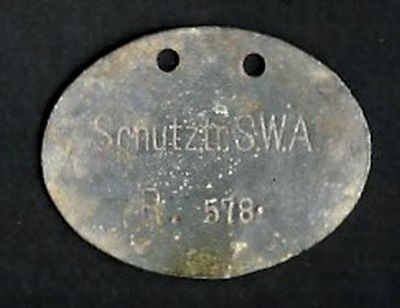
Oval
Schutztruppe Erkennungsmarke
Stamped ‘SCHUTZTR SWA’ followed by
'R' and the service number
Photo: Swakopmund Museum
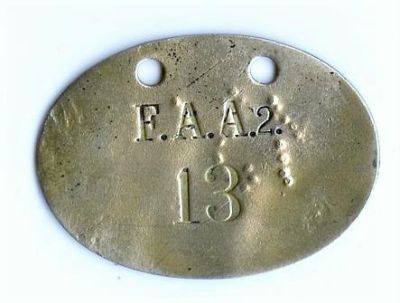
Oval
Schutztruppe Erkennungsmarke
Stamped 'F.A.A.2.' for a member of
the 2. Feldartillerie-Abteilung. This M1878 tag and its stamp follow closely the
pre-1915 German army format.
Photo from Numismatik-Cafe
and
MA Shops
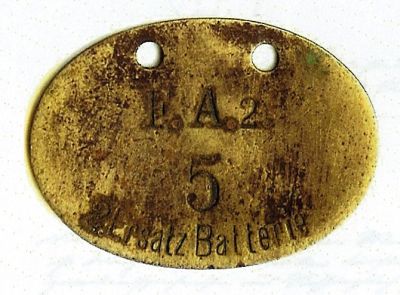
Oval
Schutztruppe Erkennungsmarke
Another oval model from the 2. Feldartillerie-Abteilung. This example is however also
stamped with the battery (2. Ersatz-Batterie).
Photo from 'Marken und Token der ehemaligen deutschen
Kolonien' by Nils Leipner
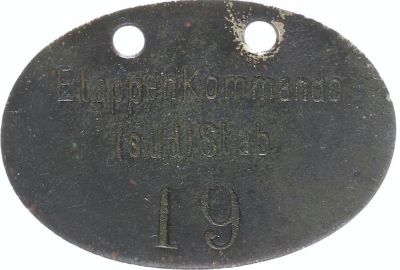
Oval
Schutztruppe Erkennungsmarke
This example is marked for
the staff of the Schutztruppe's
Southern Command, 'Etappenkommando (süd) Stab. The
South West African
Schutztruppe was divided into two staff commands,
north and south.
Photo from
MA-Shops |
|
Deutsch-Ostafrika
Less researched is the use of Erkennungsmarken in DOA and no
known originals survive.
Schutztruppe
There are however surviving drawings of the appearance
of Schutztruppe Askari Erkennungsmarken and
references to them in contemporary accounts. Leipner illustrates a round zinc tag of
39mm diameter stamped ‘Deutsch-Ostafrika Sch.Tr.’ and note
the “Askari unit” (=Feldkompanie) is also possible. It is
unclear, when these were introduced. Morlang and Haupt both
mention, that the Askari were required to wear tags at all times
on a cord around the neck. This requirement was notable enough, that Dr. August Hauer
mentioned an instance of its lack it in
his memoirs during the First World War:
"Then I faced the first dead man.
The Askari had sat down on an isolated tree, cut
open his shoe and was apparently about to bandage his ankle
- the dressing pack was open next to him - a bullet had
entered the side of his chest. His weapons
and ID tags were missing."
Source:
Hauer, August: Kumbuke: Die Erlebnisse eines Arztes in
Deutsch-Ostafrika, 3. Aufl., Berlin: Reinmar Hobbing, 1923,
P122
| |
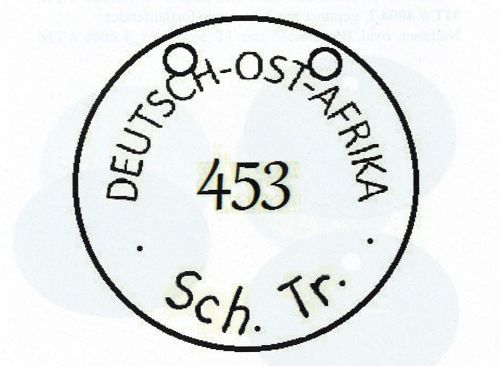
Drawing of an
Erkennungsmarke
used by East African
Schutztruppe Askaris
From
'Marken und Token der ehemaligen deutschen
Kolonien' by Nils Leipner
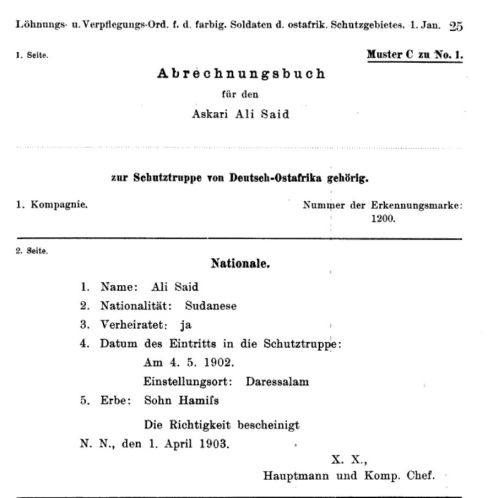
Paybook Template for Askaris
A sample entry, note the entry for the Erkennungsmarke.
Source: ‘Löhnungs-
und Verpflegungs-Ord. f. d. farbig. Soldaten d. ostafrik.
Schutzgebietes. 1. Jan. 1904’ |
|
Polizeitruppe
An order of the colonial government from 1
Feb 1892 mention Erkennungsmarken for Askari of the
newly formed Polizeitruppe were to issue by every
Polizeiabteilung and marked with the letter of the district
(T = Tanga, D = Daressalam, etc.) and a running number. Moyd
mentions that these tags were often a target for thieves to
sell as scrap metal and Polizeiaskaris had to be reminded in
a 1908 order to always wear their Erkennungsmarken, because
the “usual keeping of these by women and boys [was] not
allowed and punishable.” The punishment for a lost ID tag
was a ½ Rupie fine.
| |

Regulations for Polizeiaskari
Erkennungsmarken
Source: ‘Gouvernementsbefehl, betreffend
Theilung der Kaiserlichen Schutztruppe in eine eigentliche
Schutztruppe und Polizeitruppe. Vom 1. Februar 1892.’
|
|
Kamerun, Togo, Deutsch-Neuguinea, Samoa
No information exists on Erkennungsmarken for
these colonies except a brief mention in a paybook template
from 1906 accounting directives for the Kamerun colonial
administration. Leipner notes that surviving examples from
these colonies are unknown.
| |
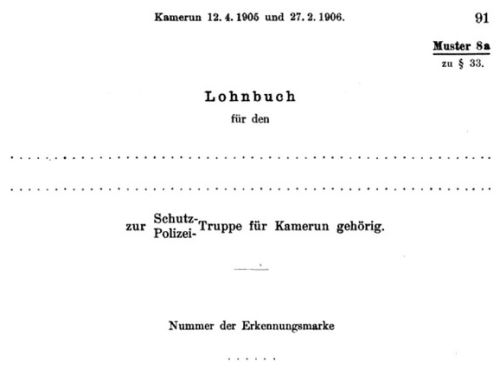
Paybook template
for African Cameroon Soldiers
Note the space for the Erkennungsmarke number.
Source: ‘Geschäftsanweisung für die
Kassen des Kaiserlichen Gouvernements von Kamerun. Vom 12.
April 1905 und 27. Februar 1906.) |
|
Tsingtau & Seebataillone
The III. Seebataillon was technically a
regular unit stationed abroad, so would use the same Erkennungsmarke
as other regular units in Germany. The same is also of
course the case for the expeditionary forces of I. and II.
SB during the Boxer Rebellion. An example for III.
Seebataillon is not
known but it would most likely be same as M1878 Erkennungsmarke
for army units while noting 'III. SB' in place of an army
regiment.
Oblt. Reinhard in ‘Mit dem II. Seebataillon
nach China!’ mentioned that the number of the Erkennungsmarke
was supposedly to match the number of the rifle and bayonet.
This claim seem questionable, because normally the ID number
was the enrolment number of the wearer, which would
probably not match the weapon at least in the army and
Schutztruppe.
| |
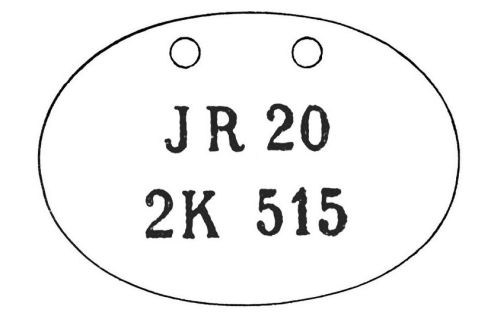
Standard Army Markings for the M1878 Erkennungsmarke
It is assumed III. Seebataillon would be noted as III. SB in place of the
JR20 of the 20th Prussian Infantry Regiment shown in
this example. Several variations on this design have
been seen, including the Stammrollennummer as a third line
or “K” stamped as “Komp.”
etc.
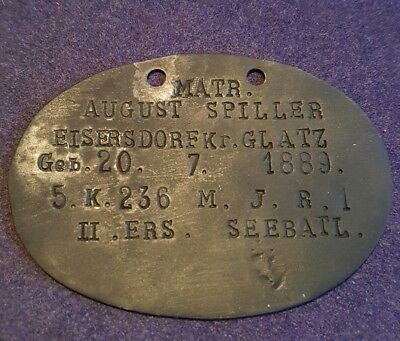
II. Seebataillon M1915 Erkennungsmarke
From 1915 a new style of
Erkennungsmarke replaced the simple M1878 type. The
new type was also a zinc oval but listed the
wearer's rank, name, address and birth date along
with full unit details. The above example is stamped
'5.K'. for 5th Company, the wearer's number in that
unit, 'M.J.R.1' for 1. Marine Infanterie Regiment, then below that 'II.ERS.
SEEBATL for the
II. Ersatz-Seebataillon. The II.
Ersatz-Seebataillon was a replacement unit of the II.SB, that
existed during Boxer Rebellion 1900-01 and again briefly in
1914 before being split into two battalions. The III. SB in
China would of course not have worn
M1915 tags.
Source: Ebay.de auction,
2018
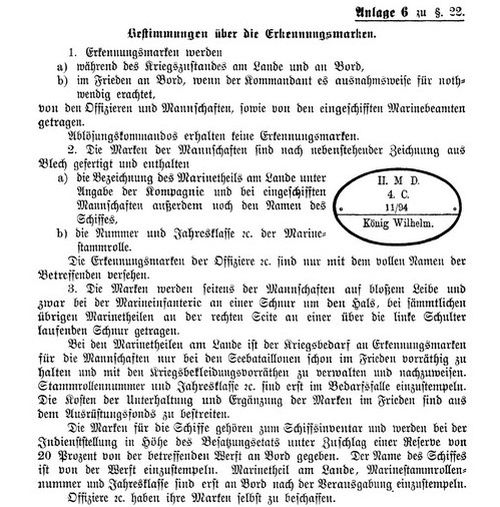
Regulations for Erkennungsmarken in
the Kaiserliche Marine
It is unclear, if the year applied
also to land units or not. It is not on later examples for
Seebataillone.
Source: Marineordnung vom 12. Nov. 1894,
Anhang 6
|
|
Bibliography
“Geschäftsanweisung für die Kassen des Kaiserlichen
Gouvernements von Kamerun. Vom 12. April 1905 und 27.
Februar 1906.”
Die deutsche Kolonial-Gesetzgebung: Sammlung, 10. Band/Jahrgang
1906.
Hauer, August: Kumbuke: Die Erlebnisse eines Arztes in
Deutsch-Ostafrika, 3. Aufl., Berlin: Reinmar Hobbing, 1923.
Haupt, Werner: Die deutsche Schutztruppe 1889/1918, Utting:
Dörfler, 1989.
Leipner, Nils: Marken und Token der ehemaligen deutschen
Kolonien, Uelzen: Nils Leipner, 2017.
Löhnungs- und Verpflegungs-Ord. f. d. farbig. Soldaten d.
ostafrik. Schutzgebietes. 1. Jan. 1904.
Die deutsche Kolonial-Gesetzgebung: Sammlung, 8. Band/Jahrgang
1904.
Marineordnung vom 12. November 1894, Anhang 6, “Bestimmungen
über die Erkennungsmarken.”
Morlang, Thomas: Askari und Fitafita: “farbige” Söldner in
den deutschen Kolonien, Berlin: Ch. Links Verlag, 2008.
Moyd, Michelle R.: Violent Intermediaries: African Soldiers,
Conquest and Everyday Colonialism in German East Africa,
Ohio: Ohio University Press, 2014.
Reinhard, Oberleutnant im II. Seebataillon: Mit dem II.
Seebataillon nach China! 1900-1901, Berlin: Verlag der
Liebelschen Buchhandlung, 1902.
Numismatik-Cafe forum threads about Schutztruppe
Erkennungsmarken.
Erkennungsmarke Kaiserl. Schutztruppe
Frühe Erkennungsmarken der Kaiserl. Schutztruppe
|
|